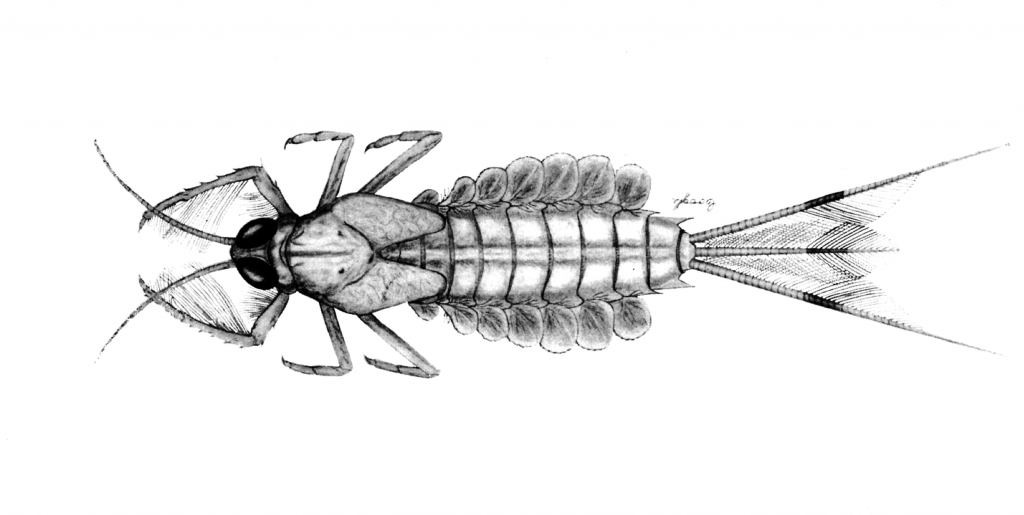What are benthic macroinvertebrates, and what is their value?
Benthic invertebrates, or aquatic insects, comprise a heterogeneous assemblage of taxa that inhabit the sediment or live on or in other bottom substrates in the aquatic environment (Klemm et. al. 1990). They vary in size from forms small and difficult to see without magnification to other individuals large enough to see without difficulty. Benthic invertebrates are large enough to be seen without magnification and can be retained by a U.S. Standard No. 30 sieve and live at least part of their life cycles within or on the substrate. A very common mayfly nymph is illustrated in Figure 1.

Figure 1. Mayfly nymph reprinted from Berner and Pescador (1988).
These organisms are effective assessment tools for many reasons (Plafkin et.al. 1989). This community of aquatic organisms is found in all aquatic habitats including very small perennial stream systems (1st and 2nd order), which normally support a very limited fish fauna. Benthic macroinvertebrates are easily and inexpensively collected. These communities integrate the effects of short-term environmental perturbations. Sensitive species respond quickly to stress, while community shifts are generally more long-term. In addition, benthic macroinvertebrate communities respond to the various types of water pollution in predictable fashions (Hocutt 1975) and are important in the diets of most fish species. Unstressed streams will support greater diversity and biological integrity than polluted streams. As water pollution is introduced into a stream system, intolerant taxa (i.e. mayflies, stoneflies and some caddisflies) disappear and are replaced by tolerant species.
Species or genus level of taxonomic identification is much preferred over family level as more precise taxonomy is necessary for pollution assessment and conservation biology (Lenat and Resh, 2001). Penrose Environmental prides itself on being able to identify the majority of specimens to at least the genus level and, in many cases species level of identification, and is familiar with the most up-to-date identification protocols and manuals.
For the most part, if semi-qualitative samples are collected from any investigation the choice of metrics to assess the data will mimic those used by the North Carolina Division of Water Resources. These metrics include calculating a biotic index using the values developed by the NC DWR as well as EPT (Ephemeroptera, Plecoptera and Trichoptera) and total taxa richness values. In many cases insect abundance is also used as a tool to define perturbation or recovery. Discussions frequently use the presence (or absence) of key taxa as well. We also can develop a list of rare or unusual taxa which can be used in conservation programs and/or assist with reclassification of Outstanding Resource Waters. If surveys are conducted outside of North Carolina a review of pertinent sections of state regulatory Standard Operating Procedures is conducted prior to sample collection. Taxonomic metrics are important assessment tools; however, the use of functional metrics can also aid in the evaluation of stream condition. Metrics such as feeding types are also frequently used to evaluate a project.
References
Barbour, M.T., J. Gerritsen, B.D. Snyder, and J.B. Stribling. 1999. Rapid Bioassessment Protocols for Use in Streams and Wadeable Rivers: Periphyton, Benthic Macroinvertebrates and Fish, Second Edition. EPA 841-B-99-002. U.S. Environmental Protection Agency; Office of Water; Washington, D.C.
Berner, L. and M.L. Pescador. The Mayflies of Florida. 1988. University Presses of Florida.
NC Division of Water Quality. Standard Operating Procedures for Benthic Macroinvertebrates. Biological Assessment Unit. October, 2012.
Hilsenhoff, W.L. 1987. An improved biotic index of organic stream pollution. Great Lakes Entomologist 20:31-39.
Hocutt, C. H. 1975. Assessment of a Stressed Macroinvertebrate Community. Water Resources Bulletin. 11(4):820-835.
Klemm, D. J., P. A. Lewis, F. Fulk and J. M. Lazorchak. 1990. Macroinvertebrate Field And Laboratory Methods For Evaluating The Biological Integrity Of Surface Waters. EPA/600/4-90-030.
Lenat, D.R. and V.H. Resh. 2001. Taxonomy and stream ecology – The benefits of genus and species-level identifications. Journal of the North American Benthological Society. 20 (2) 287-298.
Plafkin, J. L., M. T. Barbour, K. D. Porter, S. K. Gross and R. M. Hughes. 1989. Rapid Bioassessment Protocols For Use In Streams And Rivers. EPA/444/4-89-001.
